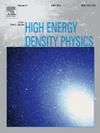Exploring the generalized fifth-order (2 + 1)-dimensional KdV equation: The lump structures and collision phenomena to the shallow water under gravity and nonlinear lattice
IF 0.9
3区 物理与天体物理
Q3 PHYSICS, FLUIDS & PLASMAS
引用次数: 0
Abstract
This study deals the lump structures and interaction phenomena to the (2 + 1)-dimensional generalized fifth-order KdV (2GKdV) equation which demonstrates long wave movements under the gravity field and in a two-dimensional nonlinear lattice in shallow water. A variety of solutions like lump periodic, collision between lumps and hyperbolic solutions as well as exponential solutions, breather waves, two wave solutions are under consideration. The Hirota perturbation expansion technique with setting nonzero background wave has been adopted for investing the studied model and securing the solutions. A lump solution is a rational function solution which is real analytic and decays in all directions of space variables. Breather waves refer to solitary waves that exhibit both partial localization and periodic structure in either space or time. Breathers serve crucial functions in nonlinear physics and have been observed in various physical domains, including optics, hydrodynamics, and quantized superfluidity. The specified parameter values produce a variety of graphs with distinctive shapes to visually represent the results. The technique’s performance, clarity, and visibility are highlighted in its suitability for various nonlinear equations in computational physics and other research domains, illustrating collision-related components and solution properties.
探索广义五阶(2 + 1)维KdV方程:重力和非线性晶格作用下浅水的团块结构和碰撞现象
本文研究了(2 + 1)维广义五阶KdV (2GKdV)方程的块体结构和相互作用现象,该方程描述了重力场作用下浅水中二维非线性点阵中的长波运动。各种各样的解,如块周期解,块间碰撞解和双曲解以及指数解,呼吸波,两波解都在考虑之中。采用设非零背景波的Hirota摄动展开技术对所研究的模型进行投资和求解。块解是一种有理函数解,它是实解析解,在空间变量的各个方向上衰减。呼吸波是指在空间或时间上表现出部分局部性和周期性结构的孤立波。呼吸体在非线性物理中起着至关重要的作用,在光学、流体力学和量子化超流体等各个物理领域都有观察到。指定的参数值产生各种形状不同的图形,以直观地表示结果。该技术的性能、清晰度和可见性突出体现在其适用于计算物理和其他研究领域的各种非线性方程,说明了与碰撞相关的组件和解的性质。
本文章由计算机程序翻译,如有差异,请以英文原文为准。
求助全文
约1分钟内获得全文
求助全文
来源期刊

High Energy Density Physics
PHYSICS, FLUIDS & PLASMAS-
CiteScore
4.20
自引率
6.20%
发文量
13
审稿时长
6-12 weeks
期刊介绍:
High Energy Density Physics is an international journal covering original experimental and related theoretical work studying the physics of matter and radiation under extreme conditions. ''High energy density'' is understood to be an energy density exceeding about 1011 J/m3. The editors and the publisher are committed to provide this fast-growing community with a dedicated high quality channel to distribute their original findings.
Papers suitable for publication in this journal cover topics in both the warm and hot dense matter regimes, such as laboratory studies relevant to non-LTE kinetics at extreme conditions, planetary interiors, astrophysical phenomena, inertial fusion and includes studies of, for example, material properties and both stable and unstable hydrodynamics. Developments in associated theoretical areas, for example the modelling of strongly coupled, partially degenerate and relativistic plasmas, are also covered.
 求助内容:
求助内容: 应助结果提醒方式:
应助结果提醒方式:


